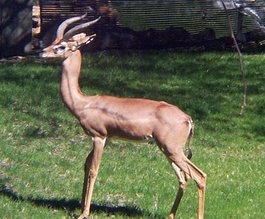Gerenuk
Its Amazing Adaptations:The Gerenuk is a species of antelope. Gerenuk means giraffe necked in the Somail language. Gerenuks have quite a few extraodinary adaptations. Thier long giraffe necks and skinny legs help them reach the branches high up on the trees. This is very useful as there are over 91 species of antelope and over 40 live in Africa. Since food and water in Africa is very scarce, their ability to stand up is very helpful as they then can reach the leaves on the trees. Their main predators are big cats such as Lions, Tigers and Cheetahs, they have adapted to survive their predators by growing such large ears which can hear from far distances, so if a predator is near by they will know where they are coming from. Their long thin legs also have the ability to run very fast.
|


